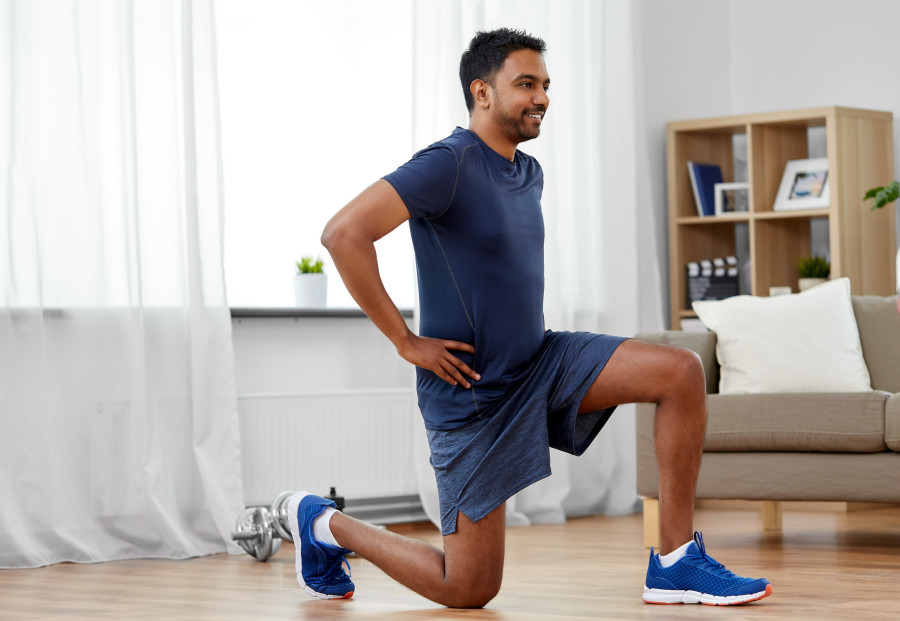Life & Style
Staying fit at home
Fitness coach Sadikshya Vaidya explains the benefits and techniques of no-equipment home workouts.
Post Report
Staying fit may not always require fancy gym equipment. No-equipment home workouts can also be a convenient way to get the sweat on without the need for costly gear. From bodyweight exercises to creative use of household items, there’s an abundance of options to keep one active and healthy right in the comfort of one’s own home.
Fitness coach and nutritionist Sadikshya Vaidya provides a rundown on the nature, benefits and proper ways of doing no-equipment home workouts.
What are the key benefits of no-equipment home workouts compared to gym-based or equipment-dependent exercises?
One of the main advantages is that you don’t need any equipment for your workouts. This means you can exercise anywhere, anytime. This flexibility is especially helpful for people who struggle with managing their time to stay fit. It also removes the complexity of using equipment, which makes it appealing for those who aren't familiar with workout gear.
In addition to its flexibility, no-equipment home workouts are a good option for beginners who want to focus on learning basic movements. They're also ideal for individuals who already have strong bodies and want to enhance their strength further through callisthenics exercises.
What types of exercises or movements are best suited for home workouts without equipment?
Movements like squats, lunges, push-ups, pull-ups, and planks are fundamental exercises that don't require any equipment. They use your body weight to provide resistance, making them accessible to anyone, anywhere. These movements can be modified to make them easier or harder, so they can be altered to suit an individual's fitness level.
Beyond building strength, it's important to incorporate cardiovascular exercises into your routine to improve endurance and overall fitness. While traditional cardio equipment like treadmills or ellipticals may not be available, there are plenty of effective alternatives that can be done without any equipment. Exercises like burpees, jumping jacks, and high knees elevate your heart rate and engage multiple muscle groups simultaneously, providing a full-body workout.
Can you outline some basic guidelines for creating effective no-equipment workouts at home?
Defining “effective” in the context of a no-equipment workout can vary depending on individual goals. For some, it might mean achieving weight loss, while for others, it could be about breaking a good sweat or improving overall fitness levels. Ultimately, effectiveness is about achieving desired outcomes, whether they be physical, mental, or both.
The first step in creating an effective no-equipment workout routine is determining your weekly workout frequency. Depending on your schedule and fitness goals, this could range from three to seven sessions.
Next, you can select three to seven basic movements to include in each session. These could include exercises like squats, lunges, push-ups, planks, burpees, and jumping jacks, among others. The key is to choose exercises that target different muscle groups and provide a balanced full-body workout. If you feel like you need help correcting your form or creating a nice workout plan, reach out to a professional.

How do such workouts contribute to overall fitness goals such as weight loss or muscle gain?
Bodyweight exercises are indeed valuable for achieving fitness goals. When it comes to weight loss, it’s essential to complement your workouts with a balanced and nutritious diet. Exercise alone may not be sufficient to achieve significant weight loss; dietary changes are often necessary to create a calorie deficit and promote fat loss.
Bodyweight exercises can be effective for muscle gain, especially for beginners. Initially, movements like squats, lunges, and bridges can provide enough resistance to stimulate muscle growth. However, as your body adapts to these exercises, the stimulus they provide may become less effective for continued strength development and muscle growth.
To overcome this, individuals seeking muscle gain may need to incorporate additional forms of resistance, such as resistance bands, dumbbells, or barbells, into their workouts. These external forms of resistance can provide the necessary stimulus to continue challenging and building muscle mass.
Additionally, varying your bodyweight exercises by increasing repetitions, changing tempo, or incorporating advanced variations can help keep your workouts challenging and stimulate further muscle growth.
Are there any safety considerations people should keep in mind when performing such exercises at home?
Certainly! Maintaining proper form during exercise is crucial to prevent discomfort, pain, or injury. Incorrect form over time can strain muscles or joints, leading to potential long-term issues. If hiring a trainer or a coach is an option for you, I’d recommend doing that. A few sessions with a good trainer can help you get your basic forms correct, and you can continue on your own.
Also, it is better to consult a doctor if someone has medical conditions such as high/low blood pressure or diabetes while looking to do these exercises.




 18.37°C Kathmandu
18.37°C Kathmandu









